Hausdorff Distance Model-Based Identity Authentication for IP Circuits in Service-Centric Internet-of-Things Environment †
Abstract
1. Introduction
2. Preliminaries
2.1. Intellectual Property (IP) Circuit Based on Hausdorff Distance
2.2. Hausdorff Distance-Based Constraint Model
3. Hausdorff Distance-Based Authentication Algorithm
3.1. Position Selection
| Algorithm 1: IP Marks embedding the algorithm |
| Input: (i) Position (ii) Marks sequence Output: (i) Pseudo position (ii) Constraint function /*Marks sequence , means that after the Marks sequence is embedded, the virtual position generated by the constraint */ /* represent unused resource sequence */ 1: Single location information selected from ; 2: Calculate by Constraint function and ; 3: Calculate Single pseudo location information by Constraint function and ; 4: If then 5. Store location information and ; 6: Else if then 7: Delete the element from the collection ; 8: End If 9: Store in ; 10: For i:= 0 to 11: Embed into Location in ; 12: End For 13: Output and ; |
3.2. Position Characteristic Matching
- Generate the IP design for identification data insertion. The integrated circuit is implemented using design tools such as ISE or Quartus, Modelsim and Synplify synthesis tool for further implementation. The bitfile design is generated for a specific FPGA device.
- Generate the identification data. The insertion procedure is illustrated by an example of inserting two identification data, M1 and M2, that should be transformed into binary data at first.
- Search the positions for inserting identification data by traversing the point set and indexes ascendingly. The binary data is orderly inserted into the selected positions. With the traversing algorithm, the characteristic value of the selected position can be calculated. Meanwhile, it can be regarded as the clue to determine the virtual positions, whereas the positions are stored with tree indexes. Besides, the priority queue is used to control the accessed sub-nodes.
- Classifying the positions of LUTs with scanning algorithm, i.e., used and unused LUT collection. In the unused collection, the LUTs with the number equal to the fragments of the identification data are selected. The Hausdorff distance is applied to calculate the characteristic matching degree between the IP cores that includes the selected positions and those with the unselected positions. Within the constraint range ε, a position collection for inserting identification data can be determined and denoted by LOC1. LOC1 is stored in a key file, and the position mapping algorithm is further mapped to get virtual position collection LOC2. In this case, the real positions are covered to ensure better security. Finally, Hausdorff distance is used to verify LOC2, if the verification result is within the range of ε. If positive, the mapping will be successful; the positions should be selected again if otherwise. The position mapping can avoid the attackers obtaining the real positions of identification data from the key file. Thus, the stored position collection LOC1 in the key file is not the real position to insert the identification data.
- Modify or replace the control state of LUT resources. The generated identification data can be inserted into the selected secure positions, as some extra connections are added to make the newly added resources integrate with the functional resources, and potentially enhance the security of the identification data. The identification data matching algorithm is depicted in Algorithm 2.
| Algorithm 2: IP Marks matching algorithm |
| Input: (i) Pseudo Position (ii) Marks sequence Output: (i) Current design /*Marks sequence , Current design means that the location of the information for embedding the Marks */ /*Compare the size of and */ 1: gets(); gets(); /*Traversing each element of the collection and the collection */ 2: for (i=0; !=’\0’&&!=’\0’; i++); 3: if () 4: break; 5: else if 6: Embed into Location in ; 7: Store in ; 8: End If 9: End For 10: Output ; |
3.3. Authentication of Identification Data
| Algorithm 3: IP Marks Authentication algorithm |
| Input: (i) Position and (ii) Constraint function Output: (i) Legal user (ii) Illegal user /* To satisfy the condition , and are compared, and then judge whether is legal or not */ /* represents the element that satisfies the condition of , represents the same element */ 1: Calculate according to and /* Compare each of and elements */ 2: gets(); gets(); for (i = 0; i < sizeof() / sizeof(); i++) { for (j = 0; j < sizeof() / sizeof(); j++) { if (==) { Store in ; } } } 3: End for /* Evaluate the similarity */ 4: If (sizeof() / sizeof() ≥ 0.8) 5: Output: Legal user 6: else if (sizeof() / sizeof() < 0.8) 7: Output: Illegal user; |
4. Experimental Results and Analysis
4.1. Stability Evaluation
4.2. Resource Overhead
4.3. Anti-Attack Ability
4.4. Similarity Evaluation
5. Conclusions and Future Work
Author Contributions
Funding
Acknowledgments
Conflicts of Interest
References
- Lee, J.W.; Lim, D.; Gassend, B.; Suh, G.E.; van Dijk, M.; Devadas, S. A technique to build a secret key in integrated circuits for identification and authentication applications. In Proceedings of the 2004 Symposium on VLSI Circuits, Digest of Technical Papers, Honolulu, HI, USA, 17–19 June 2004; pp. 176–179. [Google Scholar]
- Klapproth, P. General architectural concepts for IP core re-use. In Proceedings of the ASP-DAC/VLSI Design 2002 7th Asia and South Pacific Design Automation Conference and 15h International Conference on VLSI Design, Bangalore, India, 11 January 2002; p. 325. [Google Scholar]
- Castillo, E.; Meyerbaese, U.; Parrilla, L.; Garcia, A.; Lloris, A. New advances for automated IP soft-core watermarking. Proc. SPIE 2009. [Google Scholar] [CrossRef]
- Chen, X.; Qu, G.; Cui, A. Practical IP watermarking and fingerprinting methods for ASIC designs. In Proceedings of the IEEE International Symposium on Circuits and Systems, Baltimore, MD, USA, 28–31 May 2017; pp. 1–4. [Google Scholar]
- Liang, W.; Wu, K.; Zhou, H.; Xie, Y. TPCM: An IP Watermarking Algorithm based on Two Dimensional Chaotic Mapping. Comput. Sci. Inf. Syst. 2015, 12, 823–841. [Google Scholar] [CrossRef]
- Abdel-Hamid, A.T.; Tahar, S.; Aboulhamid, E.M. A Survey on IP Watermarking Techniques. Des. Autom. Embed. Syst. 2004, 9, 211–227. [Google Scholar] [CrossRef]
- Echavarria, J.; Morales-Reyes, A.; Cumplido, R.; Salido, M.A. FSM merging and reduction for IP cores watermarking using Genetic Algorithms. In Proceedings of the International Conference on Reconfigurable Computing and FPGAs, Cancun, Mexico, 8–10 December 2014; pp. 1–7. [Google Scholar]
- Abbas, Y.A.; Jidin, R.; Jamil, N.; Z’aba, M.R.; Rusli, M.E. PRINCE IP-core on Field Programmable Gate Arrays (FPGA). Res. J. Appl. Sci. Eng. Technol. 2015, 10, 914–922. [Google Scholar] [CrossRef]
- Xu, J.; Long, J.; Peng, L. A scattered IP watermarking algorithm in FPGA design. J. Comput. Res. Dev. 2013, 50, 2389–2396. [Google Scholar]
- Saha, D.; Kolay, S.S. Secure public verification of IP marks in FPGA design through a zero-knowledge protocol. IEEE Trans. VLSI Syst. 2012, 20, 1749–1757. [Google Scholar] [CrossRef]
- Lach, J.; Mangione-Smith, W.H.; Potkonjak, M. Robust FPGA intellectual property protection through multiple small watermarks. In Proceedings of the Design Automation Conference, Orleans, LA, USA, 21–25 June 1999; pp. 831–836. [Google Scholar]
- Zhang, J.L.; Lin, Y.P.; Lyu, Y.Q.; Wang, X.Q. A chaotic-based publicly verifiable FPGA IP watermark detection scheme. Sci. Sin. Inf. 2013, 43, 1096–1110. [Google Scholar]
- Ebrahimi, M.; Rao, P.M.B.; Seyyedi, R.; Tahoori, M.B. Low-Cost Multiple-Bit Upset Correction in SRAM-Based FPGA Configuration Frames. IEEE Trans. VLSI Syst. 2016, 24, 932–943. [Google Scholar] [CrossRef]
- Cui, A.; Chang, C.H.; Tahar, S. A robust FSM watermarking scheme for IP protection of sequential circuit design. IEEE Trans. Comput. Aided Des. Integr. Circuits Syst. 2011, 30, 678–690. [Google Scholar] [CrossRef]
- Liang, W.; Sun, X.; Xia, Z.; Sun, D.; Long, J. A Chaotic IP Watermarking in Physical Layout Level Based on FPGA. Radioengineering 2011, 20, 118–125. [Google Scholar]
- Liang, W.; Zhang, D.; You, Z.; Li, W.; Bi, X.; Hu, Y. A Digital IP Watermarking Scheme of Based on Self-Recovery Secret Information. J. Comput. Theor. Nanosci. 2014, 11, 1727–1731. [Google Scholar] [CrossRef]
- Pappu, R.; Recht, B.; Taylor, J.; Gershenfeld, N. Physical one-way functions. Science 2002, 297, 2026–2030. [Google Scholar] [CrossRef] [PubMed]
- Lim, D.; Lee, J.W.; Gassend, B.; Suh, G.E.; van Dijk, M.; Devadas, S. Extracting secret keys from integrated circuits. IEEE Trans. VLSI Syst. 2005, 13, 1200–1205. [Google Scholar]
- Liang, W.; Sun, X.; Ruan, Z.; Long, J.; Wu, C. A Sequential Circuit-Based IP Watermarking Algorithm for Multiple Scan Chains in Design-for-Test. Radioengineering 2011, 20, 533–539. [Google Scholar]
- Zhang, J.; Liu, L. Publicly Verifiable Watermarking for Intellectual Property Protection in FPGA Design. IEEE Trans. VLSI Syst. 2017, 25, 1520–1527. [Google Scholar] [CrossRef]
- Sengupta, A.; Bhadauria, S. Untrusted Third-Party Digital IP Cores: Power-Delay Trade-off Driven Exploration of Hardware Trojan Secured Datapath during High-Level Synthesis. In Proceedings of the IEEE/ACM Great Lake Symposium on VLSI, Pittsburgh, PA, USA, 20–22 May 2015; pp. 167–172. [Google Scholar]
- Cui, A.; Luo, Y.; Chang, C.H. Static and dynamic obfuscation of scan data against scan-based side-channel attacks. IEEE Trans. Inf. Forensics Secur. 2017, 12, 363–376. [Google Scholar] [CrossRef]
- Kahng, A.B.; Lach, J.; Mangione-Smith, W.H.; Mantik, S.; Markov, I.L.; Potkonjak, M.; Tucker, P.; Wang, H.; Wolfe, J. Constraint-based watermarking techniques for design IP protection. IEEE Trans. Comput. Aided Des. Integr. Circuits Syst. 2001, 20, 1236–1252. [Google Scholar] [CrossRef]
- Arunkumar, P.; Shangari, B. A New FSM Watermarking Method to Making Authorship Proof for Intellectual Property of Sequential Circuit Design Using STG. IJMER 2012, 2, 4159–4161. [Google Scholar]
- Meana, R.W.P. Approximate Sub-Graph Isomorphism for Watermarking Finite State Machine Hardware. Master’s Thesis, University of South Florida, Tampa, FL, USA, 2013. [Google Scholar]
- Lofstrom, K.; Daasch, W.R.; Taylor, D. IC identification circuit using device mismatch. In Proceedings of the 2000 IEEE International Solid-State Circuits Conference, Digest of Technical Papers. San Francisco, CA, USA, 9 February 2002; pp. 372–373. [Google Scholar]
- Bulens, P.; Standaert, F.X.; Quisquater, J.J. How to strongly link data and its medium: The paper case. IET Inf. Secur. 2010, 4, 125–136. [Google Scholar] [CrossRef]
- Long, J.; Zhang, D.; Zuo, C.; Duan, J.; Huang, W. A robust low-overhead watermarking for field authentication of intellectual property cores. Comput. Sci. Inf. Syst. 2016, 13, 609–622. [Google Scholar] [CrossRef]
- Xu, J.; Sheng, Y.; Liang, W.; Peng, L.; Long, J. A High Polymeric Mutual Mapping IP Watermarking Algorithm for FPGA Design. J. Comput. Theor. Nanosci. 2016, 13, 186–193. [Google Scholar] [CrossRef]
- Cui, A.; Qu, G.; Zhang, Y. Ultra-Low Overhead Dynamic Watermarking on Scan Design for Hard IP Protection. IEEE Trans. Inf. Forensics Secur. 2017, 10, 2298–2313. [Google Scholar] [CrossRef]
- Taha, A.; Hanbury, A. An Efficient Algorithm for Calculating the Exact Hausdorff Distance. IEEE Trans. Pattern Anal. Mach. Intell. 2015, 37, 2153–2163. [Google Scholar] [CrossRef] [PubMed]
- Agarwal, K.; Fox, K.; Nath, A.; Sidiropoulos, A.; Wang, Y. Computing the Gromov-Hausdorff Distance for Metric Trees. arXiv, 2015; arXiv:1509.05751. [Google Scholar]
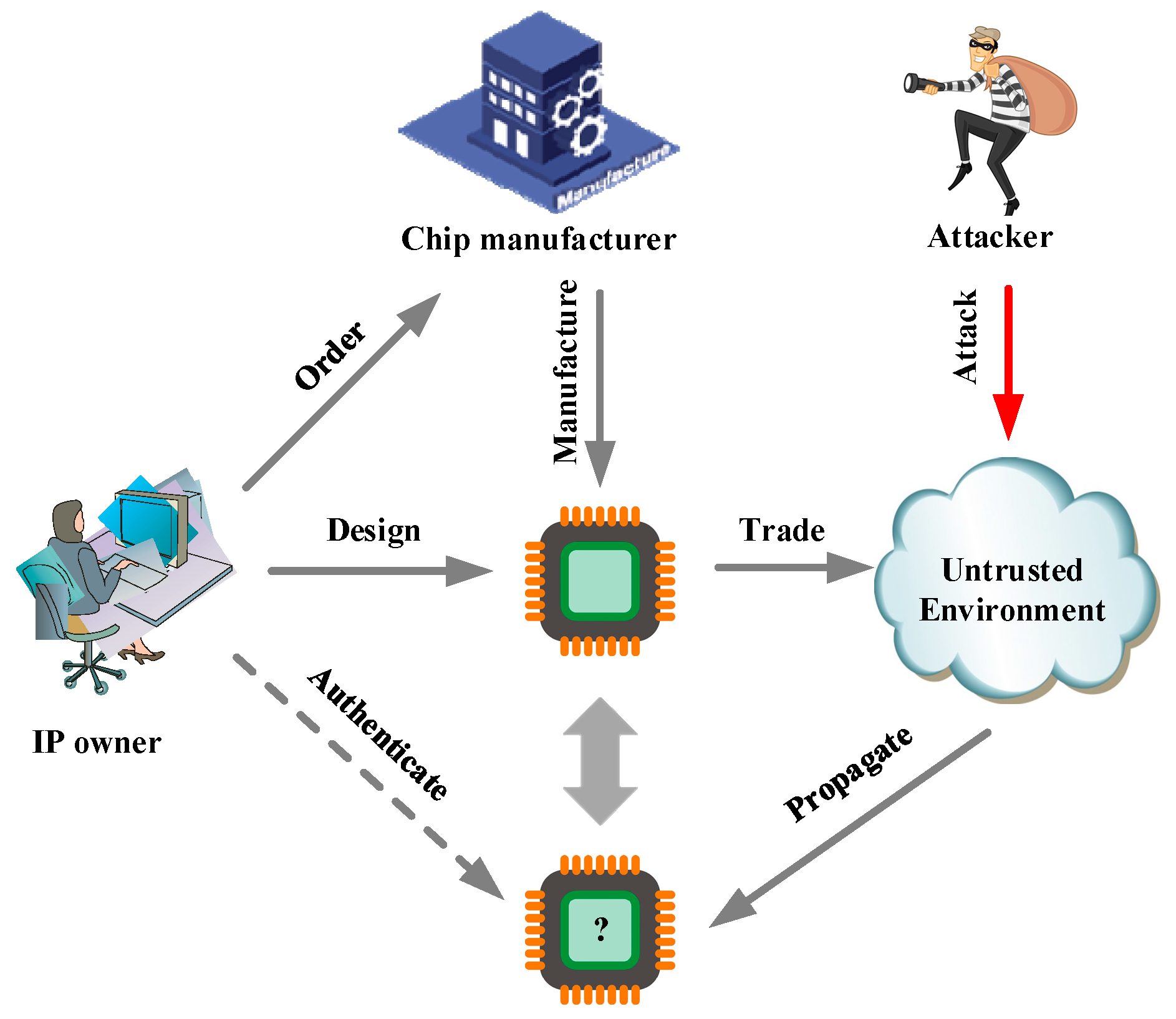
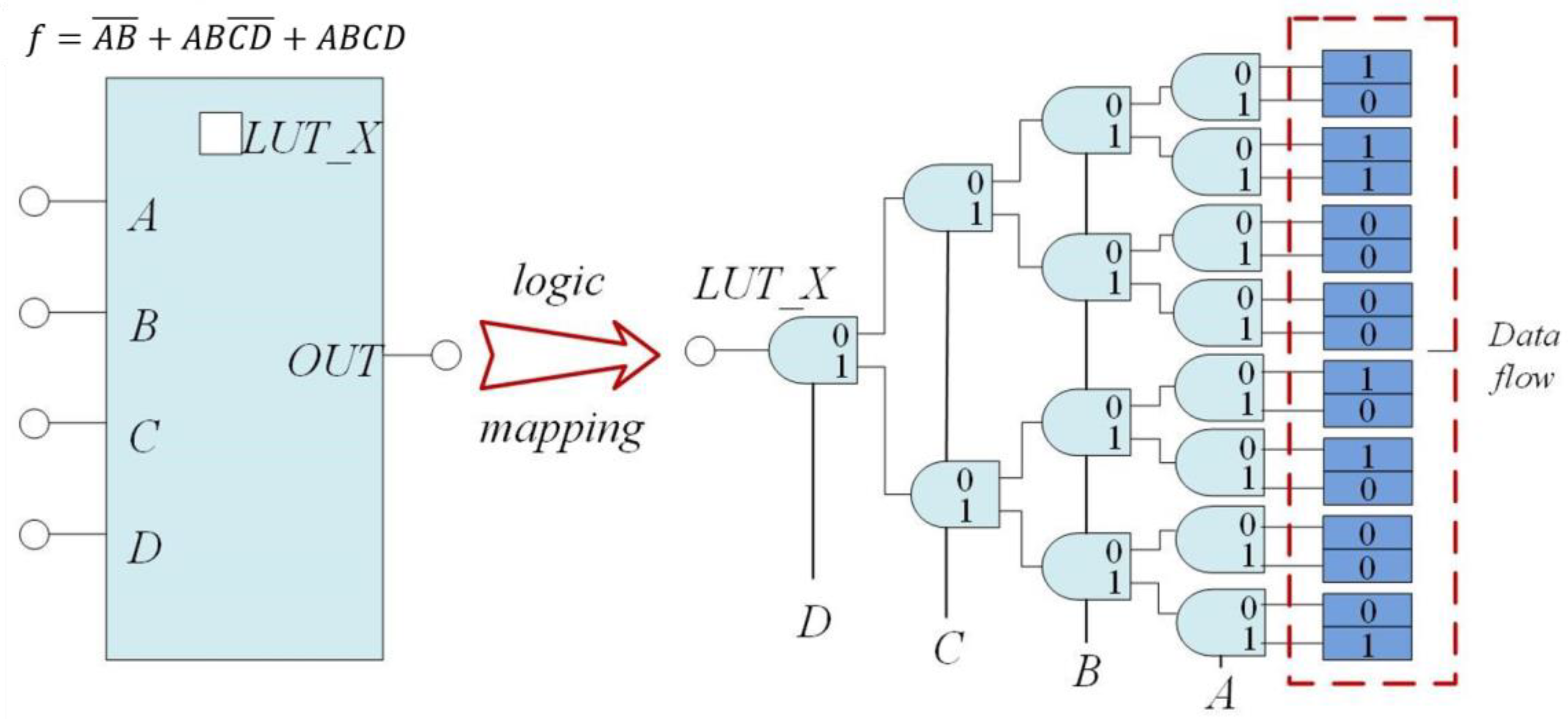
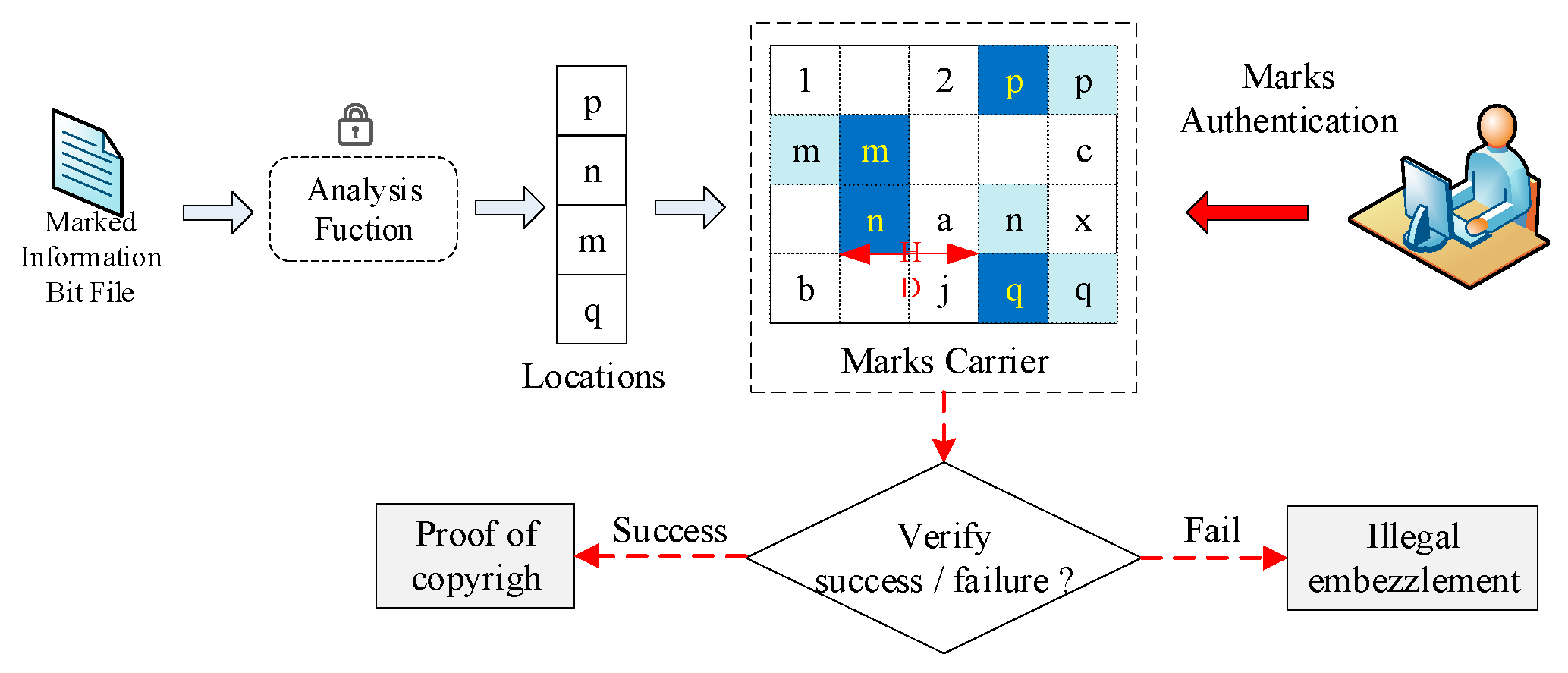
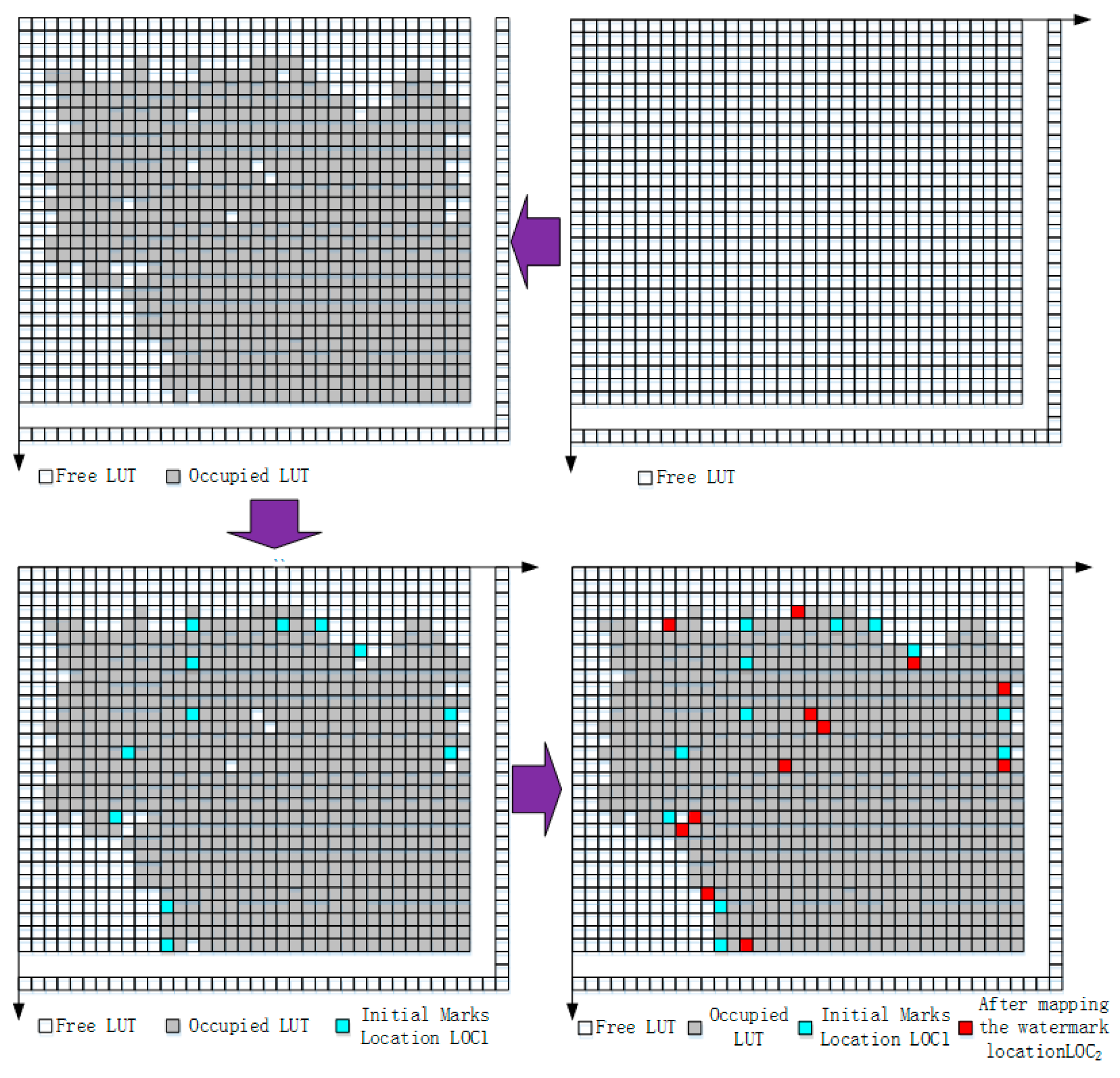
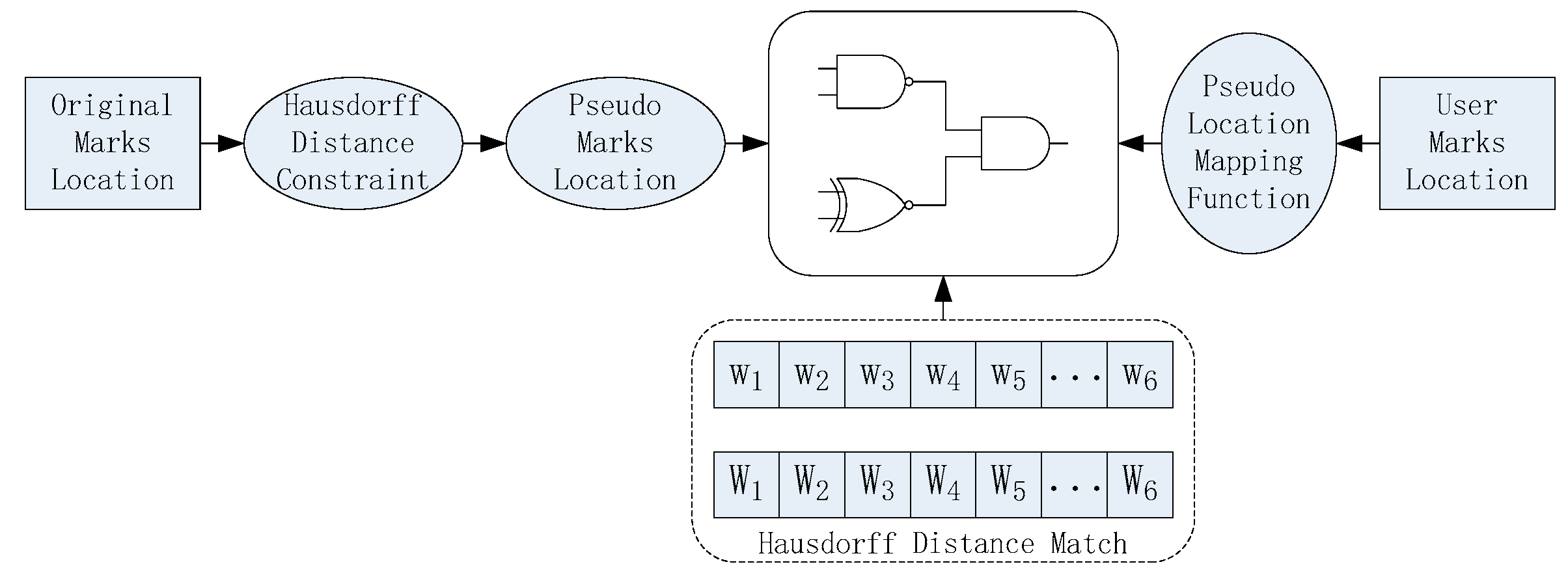
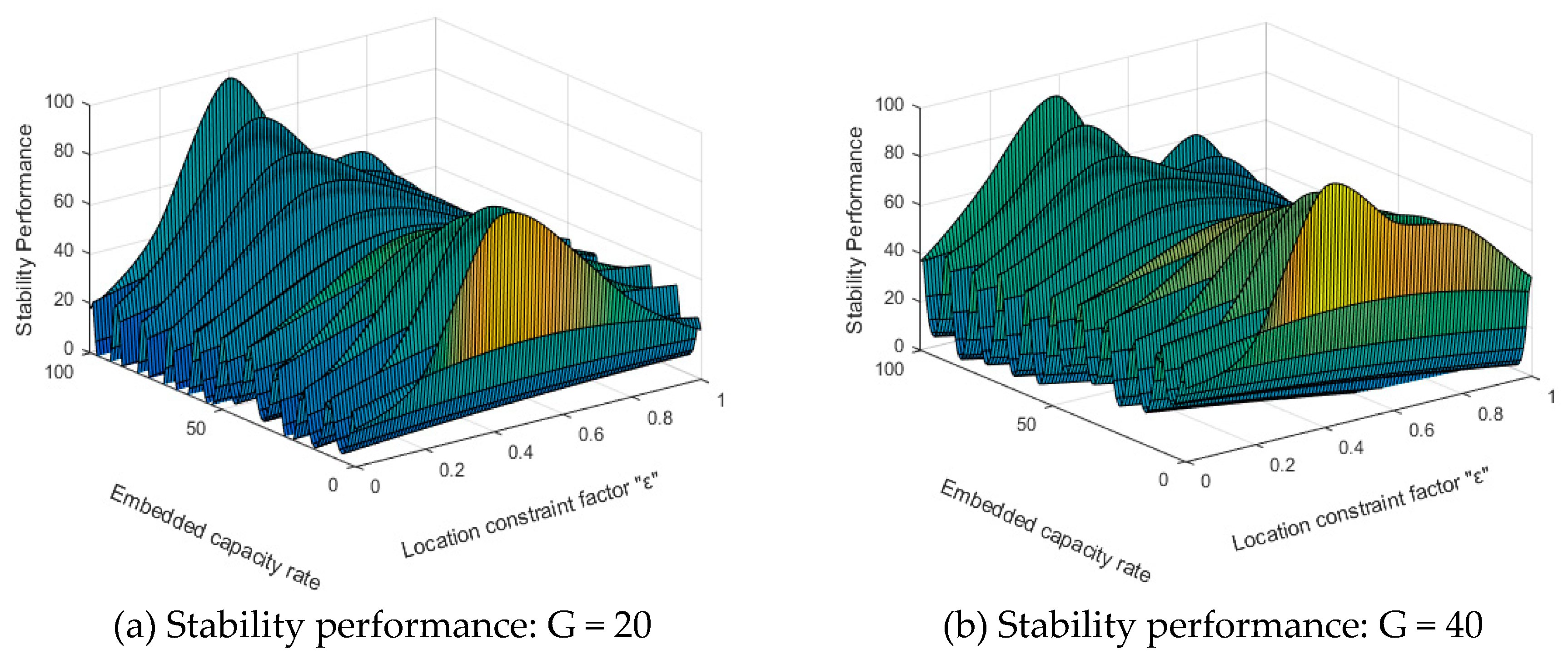
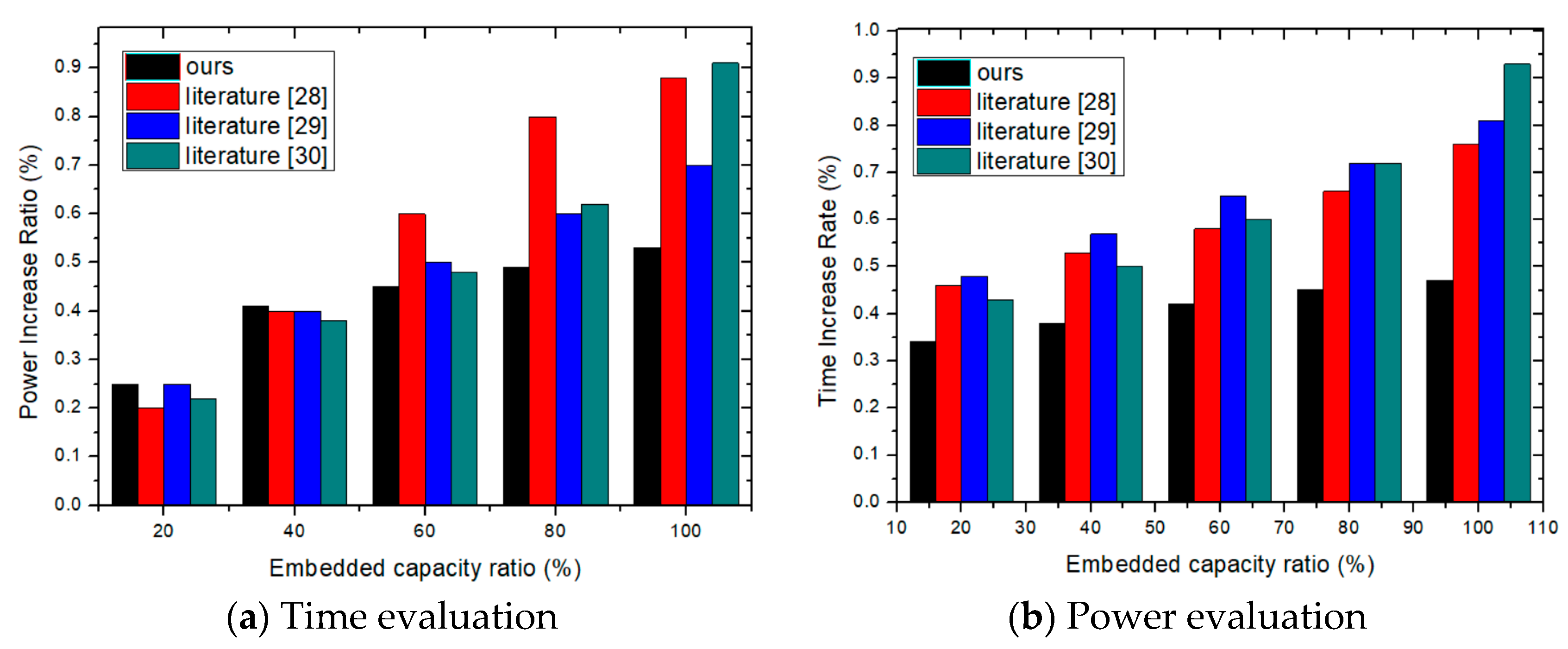
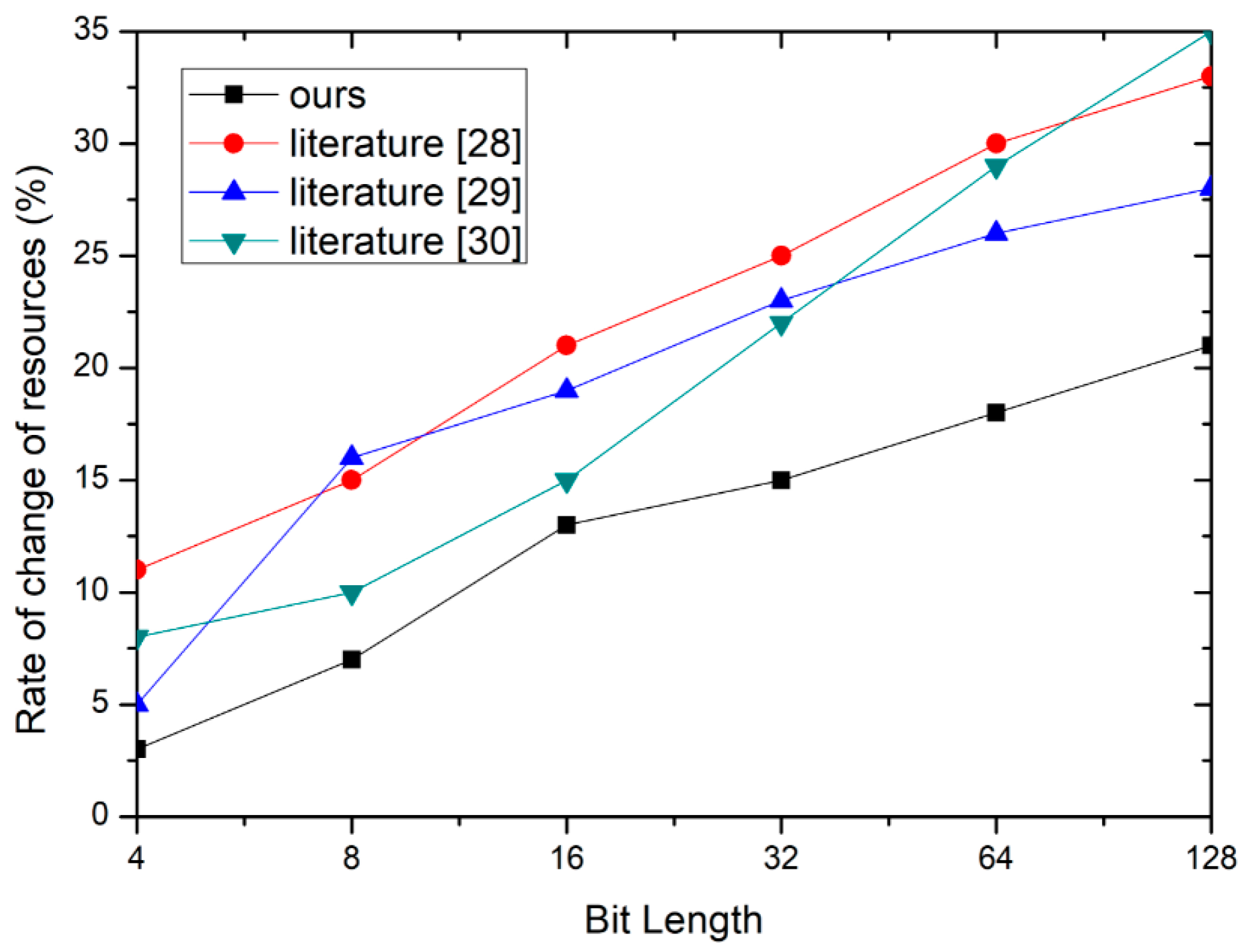
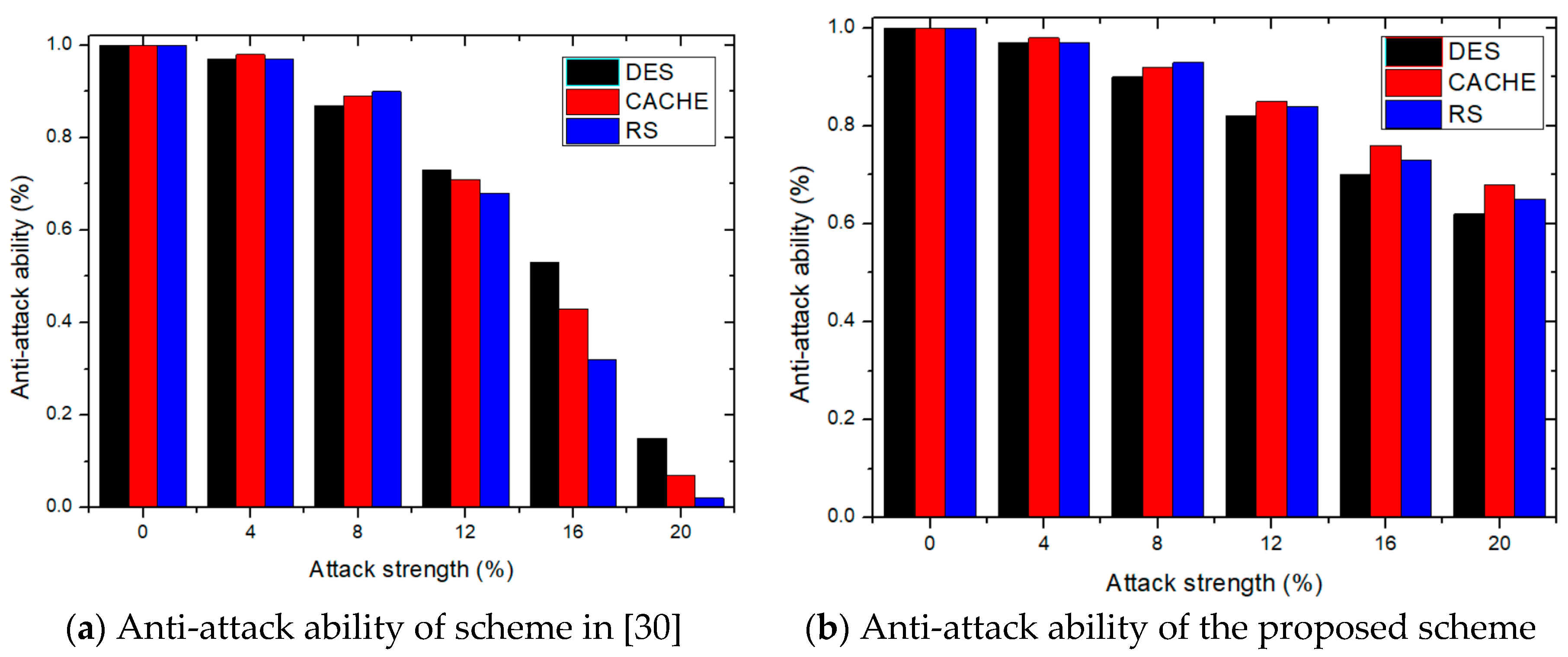
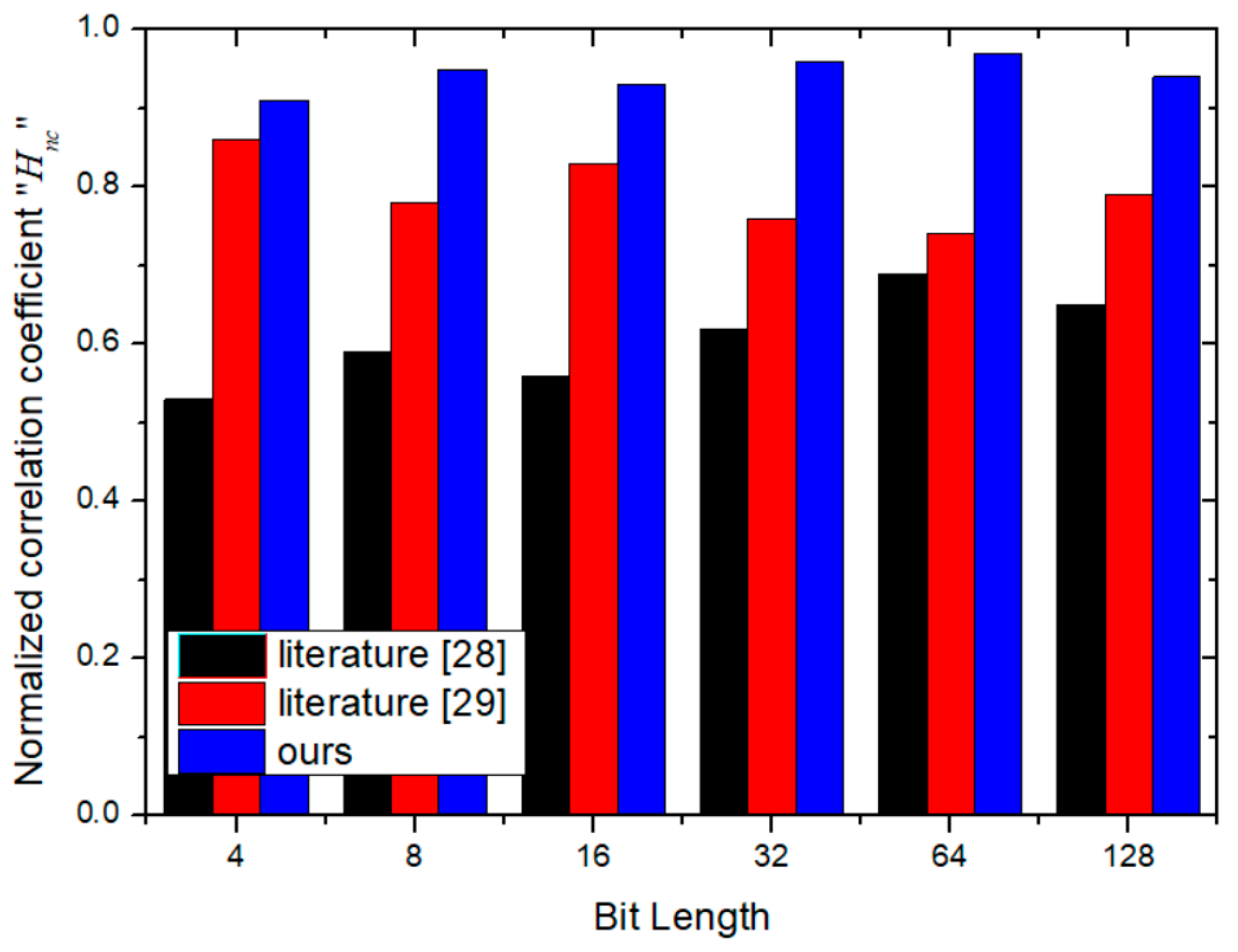
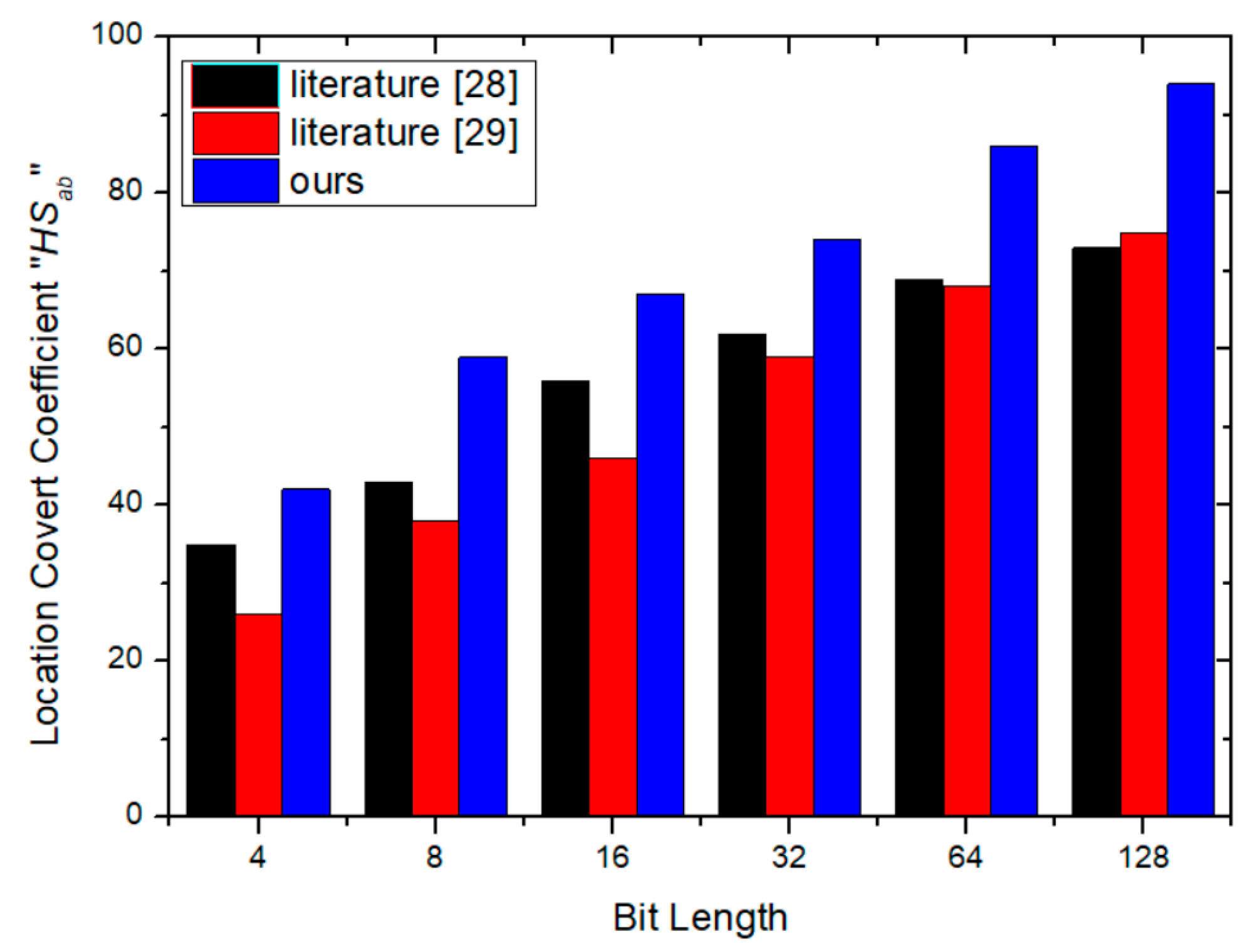
| IP Circuit | Occupied Resources | Algorithm | Average Hausdorff Distance | Time (ns) | ε |
|---|---|---|---|---|---|
| Audio | 424 | Literature [30] | - | 12.77 | 0.423 |
| Literature [29] | - | 10.56 | 0.439 | ||
| Literature [28] | - | 16.56 | 0.487 | ||
| ours | 14.43 | 7.64 | 0.439 | ||
| DES | 7064 | Literature [30] | - | 12.48 | 0.437 |
| Literature [29] | - | 12.16 | 0.498 | ||
| Literature [28] | - | 12.15 | 0.436 | ||
| ours | 17.53 | 5.13 | 0.427 | ||
| RS | 7392 | Literature [30] | - | 13.57 | 0.473 |
| Literature [29] | - | 12.49 | 0.416 | ||
| Literature [28] | - | 13.67 | 0.435 | ||
| ours | 13.42 | 6.84 | 0.484 | ||
| Cache | 14352 | Literature [30] | - | 12.29 | 0.469 |
| Literature [29] | - | 14.3 | 0.468 | ||
| Literature [28] | - | 17.82 | 0.479 | ||
| ours | 15.74 | 5.87 | 0.467 |
| Program | Replay Attack | Physical Attack | Machine Learning Attack | Fake Attacks |
|---|---|---|---|---|
| Xu | No | No | No | Yes |
| Cui | Yes | No | No | No |
| Long | Yes | No | No | Yes |
| Ours | Yes | Yes | Yes | Yes |
© 2019 by the authors. Licensee MDPI, Basel, Switzerland. This article is an open access article distributed under the terms and conditions of the Creative Commons Attribution (CC BY) license (http://creativecommons.org/licenses/by/4.0/).
Share and Cite
Liang, W.; Huang, W.; Chen, W.; Li, K.-C.; Li, K. Hausdorff Distance Model-Based Identity Authentication for IP Circuits in Service-Centric Internet-of-Things Environment. Sensors 2019, 19, 487. https://doi.org/10.3390/s19030487
Liang W, Huang W, Chen W, Li K-C, Li K. Hausdorff Distance Model-Based Identity Authentication for IP Circuits in Service-Centric Internet-of-Things Environment. Sensors. 2019; 19(3):487. https://doi.org/10.3390/s19030487
Chicago/Turabian StyleLiang, Wei, Weihong Huang, Wuhui Chen, Kuan-Ching Li, and Keqin Li. 2019. "Hausdorff Distance Model-Based Identity Authentication for IP Circuits in Service-Centric Internet-of-Things Environment" Sensors 19, no. 3: 487. https://doi.org/10.3390/s19030487
APA StyleLiang, W., Huang, W., Chen, W., Li, K.-C., & Li, K. (2019). Hausdorff Distance Model-Based Identity Authentication for IP Circuits in Service-Centric Internet-of-Things Environment. Sensors, 19(3), 487. https://doi.org/10.3390/s19030487







